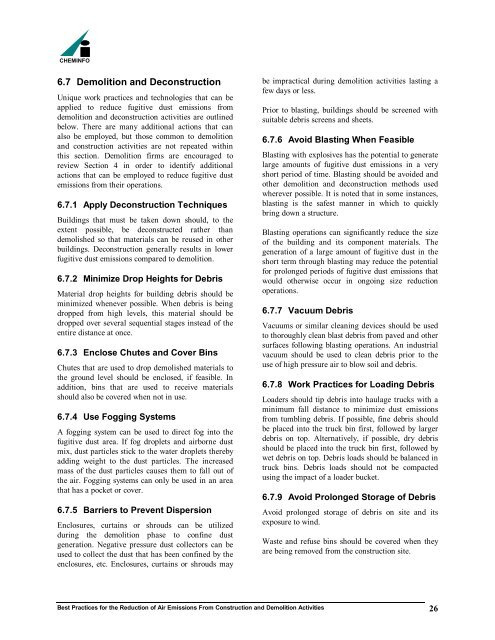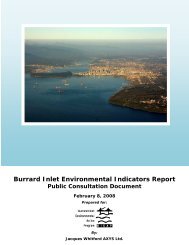Best Practices for the Reduction of Air Emissions From Construction ...
Best Practices for the Reduction of Air Emissions From Construction ...
Best Practices for the Reduction of Air Emissions From Construction ...
You also want an ePaper? Increase the reach of your titles
YUMPU automatically turns print PDFs into web optimized ePapers that Google loves.
CHEMINFO<br />
6.7 Demolition and Deconstruction<br />
Unique work practices and technologies that can be<br />
applied to reduce fugitive dust emissions from<br />
demolition and deconstruction activities are outlined<br />
below. There are many additional actions that can<br />
also be employed, but those common to demolition<br />
and construction activities are not repeated within<br />
this section. Demolition firms are encouraged to<br />
review Section 4 in order to identify additional<br />
actions that can be employed to reduce fugitive dust<br />
emissions from <strong>the</strong>ir operations.<br />
6.7.1 Apply Deconstruction Techniques<br />
Buildings that must be taken down should, to <strong>the</strong><br />
extent possible, be deconstructed ra<strong>the</strong>r than<br />
demolished so that materials can be reused in o<strong>the</strong>r<br />
buildings. Deconstruction generally results in lower<br />
fugitive dust emissions compared to demolition.<br />
6.7.2 Minimize Drop Heights <strong>for</strong> Debris<br />
Material drop heights <strong>for</strong> building debris should be<br />
minimized whenever possible. When debris is being<br />
dropped from high levels, this material should be<br />
dropped over several sequential stages instead <strong>of</strong> <strong>the</strong><br />
entire distance at once.<br />
6.7.3 Enclose Chutes and Cover Bins<br />
Chutes that are used to drop demolished materials to<br />
<strong>the</strong> ground level should be enclosed, if feasible. In<br />
addition, bins that are used to receive materials<br />
should also be covered when not in use.<br />
6.7.4 Use Fogging Systems<br />
A fogging system can be used to direct fog into <strong>the</strong><br />
fugitive dust area. If fog droplets and airborne dust<br />
mix, dust particles stick to <strong>the</strong> water droplets <strong>the</strong>reby<br />
adding weight to <strong>the</strong> dust particles. The increased<br />
mass <strong>of</strong> <strong>the</strong> dust particles causes <strong>the</strong>m to fall out <strong>of</strong><br />
<strong>the</strong> air. Fogging systems can only be used in an area<br />
that has a pocket or cover.<br />
6.7.5 Barriers to Prevent Dispersion<br />
Enclosures, curtains or shrouds can be utilized<br />
during <strong>the</strong> demolition phase to confine dust<br />
generation. Negative pressure dust collectors can be<br />
used to collect <strong>the</strong> dust that has been confined by <strong>the</strong><br />
enclosures, etc. Enclosures, curtains or shrouds may<br />
be impractical during demolition activities lasting a<br />
few days or less.<br />
Prior to blasting, buildings should be screened with<br />
suitable debris screens and sheets.<br />
6.7.6 Avoid Blasting When Feasible<br />
Blasting with explosives has <strong>the</strong> potential to generate<br />
large amounts <strong>of</strong> fugitive dust emissions in a very<br />
short period <strong>of</strong> time. Blasting should be avoided and<br />
o<strong>the</strong>r demolition and deconstruction methods used<br />
wherever possible. It is noted that in some instances,<br />
blasting is <strong>the</strong> safest manner in which to quickly<br />
bring down a structure.<br />
Blasting operations can significantly reduce <strong>the</strong> size<br />
<strong>of</strong> <strong>the</strong> building and its component materials. The<br />
generation <strong>of</strong> a large amount <strong>of</strong> fugitive dust in <strong>the</strong><br />
short term through blasting may reduce <strong>the</strong> potential<br />
<strong>for</strong> prolonged periods <strong>of</strong> fugitive dust emissions that<br />
would o<strong>the</strong>rwise occur in ongoing size reduction<br />
operations.<br />
6.7.7 Vacuum Debris<br />
Vacuums or similar cleaning devices should be used<br />
to thoroughly clean blast debris from paved and o<strong>the</strong>r<br />
surfaces following blasting operations. An industrial<br />
vacuum should be used to clean debris prior to <strong>the</strong><br />
use <strong>of</strong> high pressure air to blow soil and debris.<br />
6.7.8 Work <strong>Practices</strong> <strong>for</strong> Loading Debris<br />
Loaders should tip debris into haulage trucks with a<br />
minimum fall distance to minimize dust emissions<br />
from tumbling debris. If possible, fine debris should<br />
be placed into <strong>the</strong> truck bin first, followed by larger<br />
debris on top. Alternatively, if possible, dry debris<br />
should be placed into <strong>the</strong> truck bin first, followed by<br />
wet debris on top. Debris loads should be balanced in<br />
truck bins. Debris loads should not be compacted<br />
using <strong>the</strong> impact <strong>of</strong> a loader bucket.<br />
6.7.9 Avoid Prolonged Storage <strong>of</strong> Debris<br />
Avoid prolonged storage <strong>of</strong> debris on site and its<br />
exposure to wind.<br />
Waste and refuse bins should be covered when <strong>the</strong>y<br />
are being removed from <strong>the</strong> construction site.<br />
<strong>Best</strong> <strong>Practices</strong> <strong>for</strong> <strong>the</strong> <strong>Reduction</strong> <strong>of</strong> <strong>Air</strong> <strong>Emissions</strong> <strong>From</strong> <strong>Construction</strong> and Demolition Activities 26
















